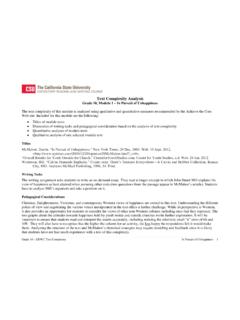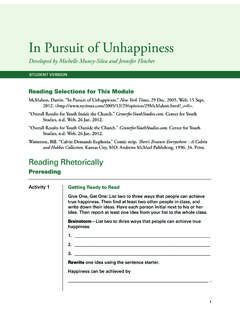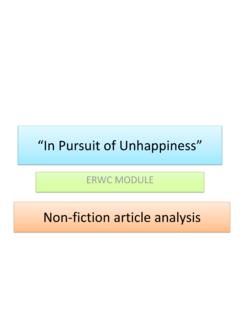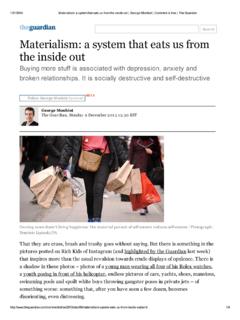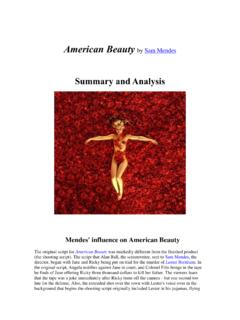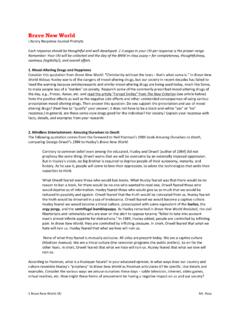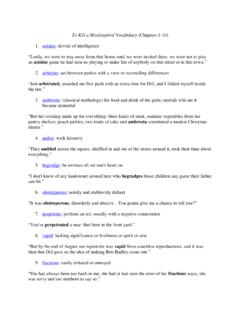Transcription of Workaholísm: Addiction to Work
1 workahol sm: Addiction to work Rachel Shifron and Rebekah R. Reysen Abstract Addiction , from the perspective of Individual Psychology, can be conceptualized as goal-oriented, creative, and chosen behavior. Shifron (1999) indicated that addic- tions are creative choices to deal with the hardships of life. In this article, workaholism is introduced as an Addiction through an Adierian framework. Workaholism is impor- tant because it negatively affects not only the individual, but also the family system. Keywords; Addiction . Individual Psychology, workaholism Following a review of the literature, Robinson (2001a) reported that the prevalence of workaholism in the United States is somewhere in the range of 25-30%. Vodanovich and Piotrowski (2006) claimed that workahol - ism has recently received much more attention, supported by R. J. Burke's (2004) observation of this tendency on an international level. Despite being a widely known concept, the research base of workaholism is undevel- oped (Aziz & Zickar, 2006; Chamberlin & Zhang, 2009; Naughton, 1987), and researchers lack an agreed-upon definition of this phenomenon (Ng, Sorensen, & Feldman, 2007).
2 The need for workaholism to be more fully understood is great, as it has been linked to negative factors including "'burnout,' 'job stress,' and 'sub- jective health complaints'" (Andreassen, Ursin, & Eriksen, 2007, p. 617), heart disease (Booth-Kewley & Friedman, 1987), and emotional difficulties (R. A. Burke, Oberklaid, & Burgess, 2004). Robinson (2000b) goes so far as to say that workaholism can "lead to unmanageable life, family disintegra- tion, serious health problems, and even death" (p. 34). This indicates that workaholics can face major repercussions as a result of their overengage- ment of the work life task. Workaholism can also negatively affect the workaholic's family. It has been linked to marital unhappiness (Robinson, Carroll, & Flowers, 2001;. Robinson, Flowers, & Ng, 2006), and the offspring of workaholic parents have been shown to have an increased risk of physical, psychological, and self-esteem issues as well (Chamberlin & Zhang, 2009).
3 Such risks make it of crucial importance for professional helpers to know how to help those and their families who suffer from workaholism. The journal of individual Psychology, Vol. 67, No. 2, Summer 2011. 2011 by the University ofTexas Press, Box 7819, Austin, TX 78713-7819. Editorial office located in the College of Education at Georgia State University. Workaholism 137. Although it has not previously been conceptualized from an Individual Psychology framework, the elements of workaholism have already been identified in the work life task, and its effects can be found in all life tasks. Therefore, the holistic psychology of Alfred Adler is an appropriate theory to use when conceptualizing workaholism. Workaholism as an Addiction Like Addiction , workaholism has been defined in a variety of ways since the term was coined by Oates (1971). For example, Griffiths (2005) noted that, over time, psychologists have begun "preferring the term ' work de- pendency' to 'workaholism' ( , work Addiction )" (p.)
4 97). Because of the similarities between workaholism and other addictions, we are introducing workaholism from an addictions paradigm. Furthermore, we will also show how workaholism can be conceptualized from both Adierian and Drei- kursian standpoints. Workaholism over time has been defined in a variety of ways. Rob- inson, Carroll, and Flowers (2001) defined workaholism as "a compulsive and progressive, potentially fatal disorder, characterized by self-imposed demands, compulsive overworking, inability to regulate work habits, and an overindulgence in work to the exclusion and detriment of intimate rela- tionships and major life activities" (pp. 397-398). Selinger (2007) echoed Robinson, Carroll, and Flowers' definition by saying that a workaholic is "someone who works at the expense of his family and personal life. Worka- holics have the compulsion to just do more work . Therefore it is different from just working hard" (p. 71). In both definitions, workaholism involves working to the point that it interferes significantly with one's life tasks, which is why we suggest that workaholism be conceptualized as an Addiction .
5 One possible reason for such an Addiction is explained by Shifron (1999): " Addiction is a creative chosen repetitious developing behavior. The goal ofthis behavior is to escape existential fears" (p. 114). These fears can be rudimentarily conceptualized as the goals of misbehavior in children, which can later become manifested in the work habits of adults. Dreikurs (1968). conceptualized children's reasons for misbehavior as being due to four ob- jectives: getting attention, control, retribution, and displaying inadequacy. Although this concept was based on children, these goals can become more complex in adolescence and even more so in adulthood, making it relevant to workaholics over the course of time. Workaholics can achieve power by working hard and becoming well known in their field or organization. They can get the attention of their peers, supervisors, and community members by achieving a high status and level of pay in their career.
6 They can also seek 138 Rachel Shifron and Rebekah R. Reysen revenge on a spouse by escaping marital problems in favor of work . Dis- playing inadequacy can also come into play when the workaholic feels that there is no other option but to work in order to keep his or her job in times of economic uncertainty and in order to maintain feelings of significance. These lifestyle attributes parallel those of addicts and demonstrate the rela- tionship between Addiction and Dreikurs's goals of misbehavior. Bauman (2000) conceptualized Addiction from the Adierian perspec- tive by using the BASIS-A Inventory (Wheeler, Kern, & Curlette, 1993) to study how lifestyle variables differ between individuals who were diagnosed with a mental health disorder, a substance use disorder, or both. Bauman found that substance abusers and those who qualified for both categories scored significantly higher on the Taking Charge scale and lower on the Going Along, Wanting Recognition, and Liked by All scales.
7 Based on these findings, we believe that workaholics would also score higher on Taking Charge as a group and are hesitant to go along with the needs or wants of anyone who stands in their way. One could also argue that some workahol - ics would score lower in Wanting Recognition if they were more focused on keeping their job than rising higher in an organization. In contrast to Bauman's results, however, it would make sense for workaholics to score higher in the Wanting Recognition category, if they are interested in a high- profile lifestyle. Finally, Addiction has been formally conceptualized by the American Psychiatric Association in the DSM-IV-TR (2000). Being substance depen- dent can involve a large amount of time spent using or acquiring a substance;. experiencing a deficit in other areas of one's life ( , the social realm); and failing to inhibit or quit its use despite how it is causing significant problems in the individual's life.
8 Van Wormer and Davis (2003) said that " Addiction ". and "substance dependence" are terms that can be used interchangeably and that "substance use is a multifactorial process involving social, psycho- logical, and biological factors .." (p. 3). Workaholics, like addicts, engage in this lifestyle despite other areas of their lives being neglected. Goal-directed Behavior in Workaholism The goal of compulsive work habits, which serve as the fundamental basis of workaholism, can be brought to life through a variety of factors. These factors can be viewed through the lens of the workforce of modern- day America, which has recently changed dramatically. In The Disposable American, Uchitelle (2006) discusses changes in both the workforce and in the expectations of employers and organizations over the years. Several decades ago, it was common for workers, once hired by a company or or- ganization, to expect to have a tenure-like status if they worked hard and Workaholism 139.
9 Were loyal to their employers. "We had decided as a people managers, politicians, and workers that job security had value, and in pursuit of that value, we lifted ourselves out of insecurity" (Uchitelle, p. 5). The goal of the worker was always to reach the tenure stage; it promoted a sense of security, stability, and enticing bonuses, like retirement packages. However, these comforts soon diminished once job tenure became less common within the organizational structure. Hall (1996) seconded Uchitelle's claims by stat- ing, "Job insecurity has soared, and any thoughts of long-term careers in one firm have been shattered" (p. 18). This state of affairs worsened, and by 2004, millions had lost their jobs. The economy, which for most of a century consisted of an alliance between employer and employee, became much more guarded as a result. Over half of the American public believes that the leaders of big business care more about their own power and rewards than they do about the well-being of their companies or their employees.
10 (Hall, 1996, p. 19). With such feelings of insecurity, those who work hard can believe that working harder than others could carve them a more secure place in the workforce. Workaholics take this idea to an even greater extreme of trying to be successful to keep their jobs despite the detrimental effects they experi- ence in other areas of their lives. This compulsiveness to work is an integral component of the worka- holic, but it is only the behavioral manifestation of insecurity. While Uchitelle (2006) and Hall and Associates (1996) described the outward reaction of workaholics, Gottfredson (1981) focused on the inward, psycho- logical realm of workaholism. Gottfredson theorized that people develop "occupational images" of what working is like in certain professions and how suitable they believe themselves to be with those images. With the view of job stability in the workforce having changed significantly over the years, Gottfredson might argue that workaholics may perhaps have a distorted view of how often they need to work in order to reach their over- all goal of keeping their job.
